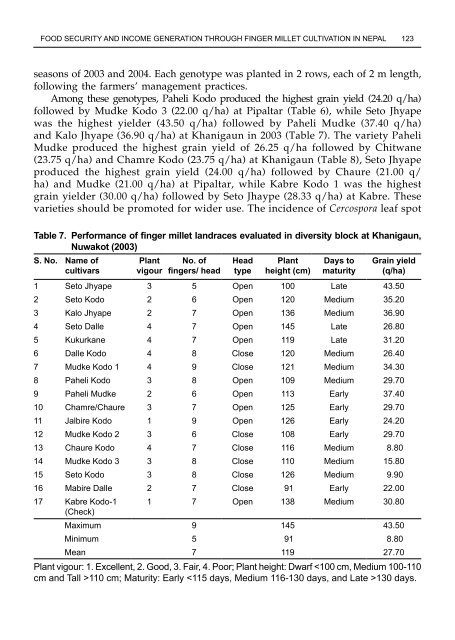Minor millets in South Asia: learnings from IFAD-NUS project in India ...
Minor millets in South Asia: learnings from IFAD-NUS project in India ...
Minor millets in South Asia: learnings from IFAD-NUS project in India ...
Create successful ePaper yourself
Turn your PDF publications into a flip-book with our unique Google optimized e-Paper software.
Food seCuritY and <strong>in</strong>Come generation through F<strong>in</strong>ger millet CultiVation <strong>in</strong> nepal 123<br />
seasons of 2003 and 2004. Each genotype was planted <strong>in</strong> 2 rows, each of 2 m length,<br />
follow<strong>in</strong>g the farmers’ management practices.<br />
Among these genotypes, Paheli Kodo produced the highest gra<strong>in</strong> yield (24.20 q/ha)<br />
followed by Mudke Kodo 3 (22.00 q/ha) at Pipaltar (Table 6), while Seto Jhyape<br />
was the highest yielder (43.50 q/ha) followed by Paheli Mudke (37.40 q/ha)<br />
and Kalo Jhyape (36.90 q/ha) at Khanigaun <strong>in</strong> 2003 (Table 7). The variety Paheli<br />
Mudke produced the highest gra<strong>in</strong> yield of 26.25 q/ha followed by Chitwane<br />
(23.75 q/ha) and Chamre Kodo (23.75 q/ha) at Khanigaun (Table 8), Seto Jhyape<br />
produced the highest gra<strong>in</strong> yield (24.00 q/ha) followed by Chaure (21.00 q/<br />
ha) and Mudke (21.00 q/ha) at Pipaltar, while Kabre Kodo 1 was the highest<br />
gra<strong>in</strong> yielder (30.00 q/ha) followed by Seto Jhaype (28.33 q/ha) at Kabre. These<br />
varieties should be promoted for wider use. The <strong>in</strong>cidence of Cercospora leaf spot<br />
Table 7. Performance of f<strong>in</strong>ger millet landraces evaluated <strong>in</strong> diversity block at Khanigaun,<br />
Nuwakot (2003)<br />
S. No. Name of<br />
cultivars<br />
Plant<br />
vigour<br />
No. of<br />
f<strong>in</strong>gers/ head<br />
Head<br />
type<br />
Plant<br />
height (cm)<br />
Days to<br />
maturity<br />
Gra<strong>in</strong> yield<br />
(q/ha)<br />
1 seto Jhyape 3 5 open 100 late 43.50<br />
2 seto Kodo 2 6 open 120 medium 35.20<br />
3 Kalo Jhyape 2 7 open 136 medium 36.90<br />
4 seto dalle 4 7 open 145 late 26.80<br />
5 Kukurkane 4 7 open 119 late 31.20<br />
6 dalle Kodo 4 8 Close 120 medium 26.40<br />
7 mudke Kodo 1 4 9 Close 121 medium 34.30<br />
8 paheli Kodo 3 8 open 109 medium 29.70<br />
9 paheli mudke 2 6 open 113 early 37.40<br />
10 Chamre/Chaure 3 7 open 125 early 29.70<br />
11 Jalbire Kodo 1 9 open 126 early 24.20<br />
12 mudke Kodo 2 3 6 Close 108 early 29.70<br />
13 Chaure Kodo 4 7 Close 116 medium 8.80<br />
14 mudke Kodo 3 3 8 Close 110 medium 15.80<br />
15 seto Kodo 3 8 Close 126 medium 9.90<br />
16 mabire dalle 2 7 Close 91 early 22.00<br />
17 Kabre Kodo-1<br />
(Check)<br />
1 7 open 138 medium 30.80<br />
maximum 9 145 43.50<br />
m<strong>in</strong>imum 5 91 8.80<br />
mean 7 119 27.70<br />
plant vigour: 1. excellent, 2. good, 3. Fair, 4. poor; plant height: dwarf 110 cm; maturity: early 130 days.

















